

Tibet Weather, Weather of Tibet: Spring, Summer, Autumn & Winter. It is important to know the Tibet weather information before you come here.
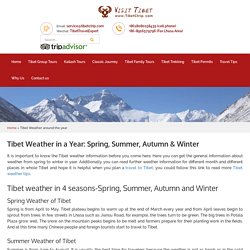
Here you can get the general information about weather from spring to winter in year. Additionally you can read further weather information for different month and different places in whole Tibet and hope it is helpful when you plan a travel to Tibet, you could follow this link to read more Tibet weather tips. Tibet weather in 4 seasons-Spring, Summer, Autumn and Winter Spring Weather of Tibet Spring is from April to May. Life expectancy of people in Tibet rises to 68.2 years: white paper. BEIJING, March 27 (Xinhua) -- The life expectancy of the people in Tibet increased from 35.5 years before 1959 to 68.2 years now, said a white paper released Wednesday by China's State Council Information Office.

Tibet - Economy. Resources and power Although Tibet is rich in mineral resources, its economy has remained underdeveloped.
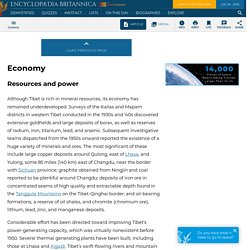
Surveys of the Kailas and Mapam districts in western Tibet conducted in the 1930s and ’40s discovered extensive goldfields and large deposits of borax, as well as reserves of radium, iron, titanium, lead, and arsenic. Subsequent investigative teams dispatched from the 1950s onward reported the existence of a huge variety of minerals and ores. The most significant of these include large copper deposits around Qulong, east of Lhasa, and Yulong, some 85 miles (140 km) east of Changdu, near the border with Sichuan province; graphite obtained from Ningjin and coal reported to be plentiful around Changdu; deposits of iron ore in concentrated seams of high quality and extractable depth found in the Tanggula Mountains on the Tibet-Qinghai border; and oil-bearing formations, a reserve of oil shales, and chromite (chromium ore), lithium, lead, zinc, and manganese deposits.
Manufacturing. Tibetan Religious Hierarchy - Hierarchy Structure. Tibet is situated in the northeast of the Himalayas in Asia.
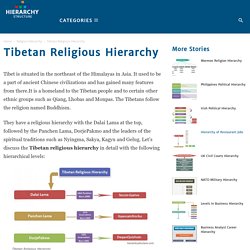
It used to be a part of ancient Chinese civilizations and has gained many features from there.It is a homeland to the Tibetan people and to certain other ethnic groups such as Qiang, Lhobas and Monpas. The Tibetans follow the religion named Buddhism. They have a religious hierarchy with the Dalai Lama at the top, followed by the Panchen Lama, DorjePakmo and the leaders of the spiritual traditions such as Nyingma, Sakya, Kagyu and Gelug.
Let’s discuss the Tibetan religious hierarchy in detail with the following hierarchical levels: Dalai LamaPanchen LamaDorjePakmo Dalai Lama. Q&A about the Dalai Lama - World news - Asia-Pacific - China. Whether going before the United Nations to publicize the plight of Tibetans under Chinese rule or appearing in events with Hollywood celebrities, the 14th Dalai Lama of Tibetan Buddhism has become a familiar face to many Westerners.
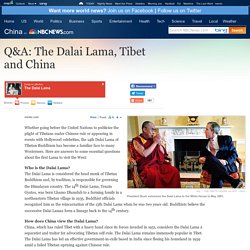
Here are answers to some essential questions about the first Lama to visit the West: Tibetan scholar and political leader. Lobsang Sangay, (born 1968, Darjiling, India), Tibetan scholar and political leader who became prime minister in the Tibetan Central Administration, the Tibetan government-in-exile, in 2011.
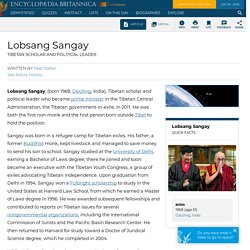
He was both the first non-monk and the first person born outside Tibet to hold the position. Sangay was born in a refugee camp for Tibetan exiles. His father, a former Buddhist monk, kept livestock and managed to save money to send his son to school. The Life of Buddha Siddhartha Gautama - Nils Oeynhausen. (Text by Barbara Hoetsu O’Brien, journalist and student of Zen Buddhism, with some alterations by myself; Photos by myself taken at Wat Doi Suthep) The life of Siddhartha Gautama, the person we call the Buddha, is shrouded in legend and myth.

Although most historians believe there was such a person, we know very little about him. The „standard“ biography appears to have evolved over time. Buddhism - Definition, Founder & Origins. Buddhism is a faith that was founded by Siddhartha Gautama (“the Buddha”) more than 2,500 years ago in India.
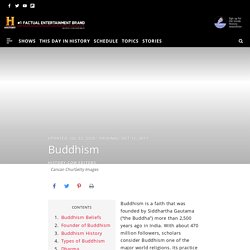
With about 470 million followers, scholars consider Buddhism one of the major world religions. Its practice has historically been most prominent in East and Southeast Asia, but its influence is growing in the West. Many Buddhist ideas and philosophies overlap with those of other faiths. Buddhism Beliefs. Who Was the Buddha, and What Did He Teach? Buddhism - Local gods and demons. Although the contemplative elite may deny the real existence of gods and demons together with the rest of phenomenal existence, the majority of Buddhists have preserved indigenous religious beliefs and practices.
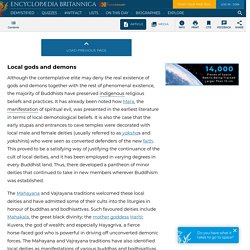
It has already been noted how Mara, the manifestation of spiritual evil, was presented in the earliest literature in terms of local demonological beliefs. It is also the case that the early stupas and entrances to cave temples were decorated with local male and female deities (usually referred to as yakshas and yakshinis) who were seen as converted defenders of the new faith. This proved to be a satisfying way of justifying the continuance of the cult of local deities, and it has been employed in varying degrees in every Buddhist land. Thus, there developed a pantheon of minor deities that continued to take in new members wherever Buddhism was established. In Theravada, Buddhism has had to come to terms with local beliefs.
EDUCATION IN TIBET. Students studying a monastery Tibet has highest illiteracy rate in China: 42 percent in 2000.
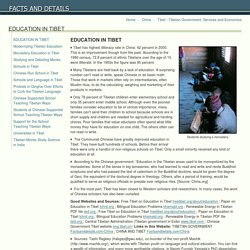
This is an improvement though from the past. According to the 1990 census, 72.8 percent of ethnic Tibetans over the age of 15 were illiterate. In the 1950s the figure was 95 percent. Many Tibetans are held back by a lack of education. A surprising number can't read or write, speak Chinese or do basic math. Only 78 percent of Tibetan children enter elementary school and only 35 percent enter middle school. The Communist Chinese have greatly improved education in Tibet.
According to the Chinese government: “Education in the Tibetan areas used to be monopolized by the monasteries. For the most part, Tibet has been closed to Western scholars and researchers. Sources: Tashi Ragbey (trabgey@gwu.edu), co-founder of the non-profit Machik ( which works with Tibetan youth on language and cultural education. Books and Studies: A) “Education in Tibet: Policy and Practice Since 1950" by Catriona Bass, St.
Tibet - New World Encyclopedia. Tibet, called “Bod” by Tibetans, or 西藏 (Xīzàng) by the Chinese, is a plateau region in Central Asia and the indigenous home to the Tibetan people. With an average elevation of 16,000 feet, (4,900 meters) it is the highest region on earth and is commonly referred to as the "Roof of the World. " China, which presently controls Tibet, maintains it is a province-level entity, the Tibet Autonomous Region. Polyandry families in Tibet. Polyandry families in Tibet Nowadays, most Tibetan marriages are monogamous with familiar 'nuclear' families. However, polyandry families in Tibet were common in ancient times. Even today, there are polyandry families in some rural areas of Tibet. Polyandry is a form of polygamy whereby a woman has several husbands.
In Tibet those husbands are often brothers, which is why it is most commonly called "Fraternal Polyandry". Melvyn C. The mechanics of fraternal polyandry are simple. Recipes Archives - Tibetan Nuns Project. Here is a recipe for Tibetan noodle soup, called thenthuk (འཐེན་ཐུག་). This comfort food is a common noodle soup in Tibetan cuisine, especially in Amdo, Tibet. Traditionally it would be made with mutton or yak meat. Links to four other recipes, including vegetarian momos, are at the bottom of this post. Traditionally, thenthuk would be made with meat, but the nuns in India eat a vegetarian diet. UNPO: Tibet. Population: 6 million Tibetans and 7.5 million Chinese Area: 2.5 million square kilometers Language: Tibetan Religions: predominantly Tibetan buddhism; Bon; Islam; Christianity.
Digging into the Diet of a Tibetan Monk. Monks are some of the most revered members of society here in Tibet. They are viewed as the ultimate source of spiritual guidance, and - with their radiant beauty, and abundant, youthful energy - the pinnacle of optimal health. For this latter reason, it is often found that even those who do not subscribe to any particular religious faith are longing to emulate these holy men. And since we are what we eat, we’re digging into the details of a traditional Tibetan monks’ diet in an effort to become more like these men we hold in such high esteem. Tibetan Customs, Customs Related to the Ethnic Culture, Religious Factors and Geography. The Legal Status of Tibet. Languages spoken in Tibet, Tibet Language guide, Languages in Tibet. BBC - Religions - Buddhism: Tibetan Buddhism. East Asia/Southeast Asia. Religion in Japan.
Shinto and Buddhism are Japan's two major religions. Shinto is as old as the Japanese culture, while Buddhism was imported from the mainland in the 6th century. Since then, the two religions have been co-existing relatively harmoniously and have even complemented each other to a certain degree. Most Japanese consider themselves Buddhist, Shintoist or both.
Religion does not play a big role in the everyday life of most Japanese people today. The average person typically follows the religious rituals at ceremonies like birth, weddings and funerals, may visit a shrine or temple on New Year and participates at local festivals (matsuri), most of which have a religious background. Religions and Philosophies Other Religion Related Pages. The Languages spoken in Japan. The Japanese Climate. From subarctic Hokkaidō to subtropical Okinawa, Japan’s climate varies greatly by region. Japanese Regions. Ancient Egypt: the Mythology and egyptian myths. Ancient Egyptian Gods and Goddesses Illustrated Descriptions and stories. Egyptian Gods Ancient Egyptian Gods and Goddesses. Egypt Population 2019 (Demographics, Maps, Graphs) Type-of-government-egypt-have.
What Type of Government Does Egypt Have? The Ancient Egyptian Religion Making a Comeback in the Modern World. Ancient Egypt exercises a powerful hold over modern imaginations, conjuring images of gilded pharaohs, towering pyramids, and stunning hieroglyphics. Egypt - Religion. Languages Spoken In Egypt. Climate information for Egypt - Climate Zone. Geographic Regions of Egypt.